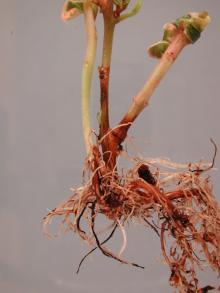See:
Greenhouse Plants, Ornamental - Pythium Seed Rot, Damping-off, and Root Rot
Cause Pythium rostratum and P. ultimum, fungus-like microorganisms. Found several times over the years by OSU's Plant Clinic. Poorly drained, waterlogged soil or media favors these water-mold organisms. They survive unfavorable periods in soil and infected plant debris. Under favorable conditions, spores germinate and infect roots. After infection, the fungus-like microorganism spreads mainly in the inner bark tissues of the root and stems. A thick-walled survival structure, oospores, are produced that can persist for several years. Movement of infected plants and/or soil can spread the organism.
Allowing fuchsias to dry between irrigations during short days is important for proper growth and root development. Once in hanging pots and especially when flowering, make sure plants do not dry out. Also, growing fuchsias under conditions that are too warm can result in soft plants that cannot withstand shipping.
Symptoms Fine roots die, turning dark brown to black. Delayed flowering and stunting were observed in greenhouse production.
Cultural control
- Do not overwater or let plants stand in waterlogged soil. Allow to dry between irrigations especially during short days.
- Use a well-drained container medium.
- Use sterile soil or potting mix and disinfect any tools or equipment that might be used and contaminate the media.
- Growing conditions require 68°F to 70°F nights and partial (not full) sun during the day. Some growers maintain growing temperatures in low 60s for day and high 50s for night, which can be increased to the mid 60s once plants are in hanging baskets.
- Media pH should be between 5.5 to 6 and check the electrolyte concentration at regular intervals. High salts have been diagnosed regularly by OSU's Plant Clinic and can contribute to Pythium root rot problems.
- Avoid reusing pots or trays from a previous crop for propagation. If pots must be reused then wash off all debris and soak in a sanitizing solution or treat with aerated steam for 30 min.
- When transplanting do not cover the root crown with excessive media or soil. Transplant back to the original soil line.
Chemical control Best when used with cultural controls. Several products could be used if they are not phytotoxic but none are specifically registered for fuchsia.
Reference Lookabaugh, E.C., Ivors, K.L., and Shew, B.B. 2015. Mefenoxam sensitivity, aggressiveness, and identification of Pythium species causing root rot on floriculture crops in North Carolina. Plant Disease 99:1550-1558.


